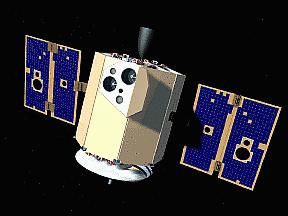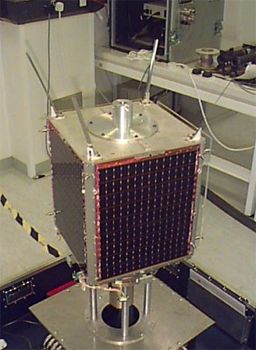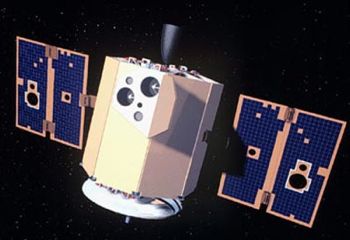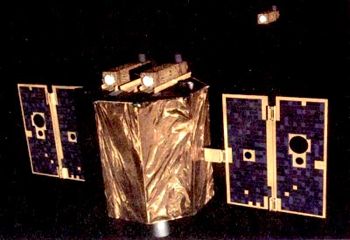
Home - Search - Browse - Alphabetic Index: 0- 1- 2- 3- 4- 5- 6- 7- 8- 9
A- B- C- D- E- F- G- H- I- J- K- L- M- N- O- P- Q- R- S- T- U- V- W- X- Y- Z
Clementine
 Clementine Credit: USAF |
Status: Operational 1994. First Launch: 1994-01-25. Last Launch: 1994-01-25. Number: 1 . Gross mass: 424 kg (934 lb). Height: 1.90 m (6.20 ft).
The principal objective was to space qualify lightweight imaging sensors and component technologies for the next generation of DOD spacecraft. Intended targets for these sensors included the Moon, a near-Earth asteroid (1620 Geographos), and the spacecraft's interstage adapter.
Clementine was a military-sponsored technology status that provided America's first mission to the moon in 25 years. After entering lunar orbit, Clementine provided over 1.6 million images of the Moon's surface. After the lunar mapping phase was completed, the spacecraft left lunar orbit for a planned encounter with the asteroid Geographos, but was unable to rendezvous due to a spacecraft computer failure on 17 May 1994. The spacecraft was shut down on 21 July 1994.
The spacecraft was 3-axis stabilized, and used dual GaAs solar arrays with 1-axis articulation. A fixed 1.1 m high gain antenna provided S-Band downlink to NASA's Deep Space Network and DoD tracking stations with downlink rate up to 128 kbps. A 1.9 Gbit solid state recorder was used for data storage. The satellite had two propulsions systems: a bipropellant system with a 489 N thruster, and a hydrazine system with 10 x 5.3 N and 7 x 22 N thrusters. The computer had a 32-bit R3000 processor. Lightweight ring laser gyro and IFOG (1 deg/hr) navigation. A NiH2 CPV battery with 15 AH capacity was used. Lightweight reaction wheels provided attitude control and star tracker cameras determined absolute position. A JPEG image compression chip from Matra Marconi reduced the size of image files prior to transmission to earth.
Payloads included two miniature star tracker cameras, a UV/Visible camera, a Near-IR camera, a Long wave IR camera, a high resolution camera, a laser transmitter, a charged particle telescope, four dosimeters, a radiation experiment, and an orbital meteoroid and debris counting experiment. Total payload was 8 kg in mass and consumed 68 watts.
Total project cost was $ 80 million, using a Titan II converted surplus ICBM as the launch vehicle.
NASA NSSDC Master Catalog Description
Clementine was a joint project between the Ballistic Missile Defense Organization (BMDO, nee the Strategic Defense Initiative Organization, or SDIO) and NASA. The objective of the mission was to test sensors and spacecraft components under extended exposure to the space environment and to make scientific observations of the Moon and the near-Earth asteroid 1620 Geographos. The Geographos observations were not made due to a malfunction in the spacecraft. The lunar observations made included imaging at various wavelengths in the visible as well as in ultraviolet and infrared, laser ranging altimetry, gravimetry, and charged particle measurements. These observations were for the purposes of obtaining multi-spectral imaging the entire lunar surface, assessing the surface mineralogy of the Moon and obtaining altimetry from 60N to 60S latitude and gravity data for the near side. There were also plans to image and determine the size, shape, rotational characteristics, surface properties, and cratering statistics of Geographos. Clementine carried seven distinct experiments on-board: a UV/Visible Camera, a Near Infrared Camera, a Long Wavelength Infrared Camera, a High Resolution Camera, two Star Tracker Cameras, a Laser Altimeter, and a Charged Particle Telescope. The S-band transmitter was used for communications, tracking, and the gravimetry experiment.
Spacecraft and Subsystems
The spacecraft was an octagonal prism 1.88 m high and 1.14 m across with two solar panels protruding on opposite sides parallel to the axis of the prism. A high-gain fixed dish antenna was at one end of the prism, and the 489 N thruster at the other end. The sensor openings were all located together on one of the eight panels, 90 degrees from the solar panels, and protected in flight by a single sensor cover. The spacecraft propulsion system consisted of a nonpropellant hydrazine system for attitude control and a bipropellant nitrogen tetraoxide and monomethyl hydrazine system for the maneuvers in space. The bipropellant system had a total capability of about 1900 m/s with about 550 m/s required for lunar insertion and 540 m/s for lunar departure. Attitude control was achieved with 12 small attitude control jets, two star tracker cameras, and two inertial measurement units. The spacecraft was three-axis stabilized in lunar orbit via reaction wheels with a precision of 0.05 Deg. in control and 0.03 Deg. in knowledge. Power was provided by gimbaled, single axis, GaAs/Ge solar panels which charged a 15 amp-hour, 47 W-hr/kg Nihau (Ni-H) common pressure vessel battery. Spacecraft data processing was performed using a MIL-STD-1750A computer (1.7 million instructions per second) for savemode, attitude control, and housekeeping operations, a RISC 32-bit processor (18 million ips) for image processing and autonomous operations, and an image compression system provided by the French Space Agency CNES. A data handling unit sequenced the cameras, operated the image compression system, and directed the data flow. Data was stored in a 2 Gbit dynamic solid state data recorder.
Mission Profile
The mission had two phases. After two Earth flybys, lunar insertion was achieved approximately one month after launch. Lunar mapping took place over approximately two months, in two parts. The first part consisted of a five hour elliptical polar orbit with a periapsis of about 400 km at 30 degrees south latitude and an apoapsis of 8300 km. Each orbit consisted of an 80 minute lunar mapping phase near periapsis and 139 minutes of downlink at apoapsis. After one month of mapping the orbit was rotated to a periapsis at 30 degrees north latitude, where it remained for one more month. This allowed global imaging and altimetry coverage from 60 degrees south to 60 degrees north, over a total of 300 orbits. After a lunar/Earth transfer and two more Earth flybys, the spacecraft was to head for Geographos, arriving three months later for a flyby, with a nominal approach closer than 100 km. Unfortunately, on 07 May 1994, after the first Earth transfer orbit, a malfunction aboard the craft caused one of the attitude control thrusters to fire for 11 minutes, using up its fuel supply and causing Clementine to spin at 80 rpm. Under these conditions, the asteroid flyby could not yield useful results, so the spacecraft was put into a geocentric orbit passing through the Van Allen radiation belts to test the various components on board. The mission ended in June 1994 when the power level onboard dropped to a point where the telemetry from the spacecraft was no longer intelligible.
Further information and links to other resources are available at:
http://nssdc.gsfc.nasa.gov/planetary/clementine.html
More at: Clementine.
| Clementine 2 (DSPSE 2) Null |
Family: Lunar Orbiters, Moon. Country: USA. Engines: R-4D. Launch Vehicles: Titan, Titan II, Titan II SLV. Launch Sites: Vandenberg, Vandenberg SLC4W. Agency: NASA, NRL, Livermore, BMDO. Bibliography: 2, 296, 3643, 6, 6417, 12181.
 | Clementine Credit: Manufacturer Image |
 | Clementine Credit: Manufacturer Image |
 | Clementine Credit: Manufacturer Image |
1994 January 25 - . 16:34 GMT - . Launch Site: Vandenberg. Launch Complex: Vandenberg SLC4W. LV Family: Titan. Launch Vehicle: Titan II SLV.
- Clementine 1 - .
Payload: Clementine 1 / DSPSE-ISA [Star-37FM]. Mass: 424 kg (934 lb). Nation: USA.
Agency: BMDO.
Class: Moon.
Type: Lunar probe. Spacecraft: Clementine.
USAF Sat Cat: 22973 . COSPAR: 1994-004A. Apogee: 409,890 km (254,690 mi). Perigee: 804 km (499 mi). Inclination: 63.80 deg. Period: 16,158.80 min.
SDIO sensor technology demonstration; mapped lunar surface; planned asteroid flyby cancelled due to spacecraft failure. After two Earth flybys, lunar insertion was achieved on February 21. Lunar mapping took place over approximately two months, in two parts. The first part consisted of a 5 hour elliptical polar orbit with a perilune of about 400 km at 28 degrees S latitude. After one month of mapping the orbit was rotated to a perilune of 29 degrees N latitude, where it remained for one more month. This allowed global imaging as well as altimetry coverage from 60 degrees S to 60 degrees N. After leaving lunar orbit, a malfunction in one of the on-board computers on May 7 at 14:39 UTC (9:39 AM EST) caused a thruster to fire until it had used up all of its fuel, leaving the spacecraft spinning at about 80 RPM with no spin control. This made the planned continuation of the mission, a flyby of the near-Earth asteroid Geographos, impossible. The spacecraft remained in geocentric orbit and continued testing the spacecraft components until the end of mission. Additional Details: here....
1994 February 20 - .
- Clementine, Moon Orbit Insertion - . Nation: USA. Spacecraft: Clementine.
1994 July 21 - .
- Clementine asteroid flyby cancelled - . Nation: USA. Spacecraft: Clementine. After the lunar mapping phase was completed, the spacecraft left lunar orbit for a planned encounter with Geographos, but a computer fialure on 17 May 1994 led to the flyby being cancelled..
Back to top of page
Home - Search - Browse - Alphabetic Index: 0- 1- 2- 3- 4- 5- 6- 7- 8- 9
A- B- C- D- E- F- G- H- I- J- K- L- M- N- O- P- Q- R- S- T- U- V- W- X- Y- Z
© 1997-2019 Mark Wade - Contact
© / Conditions for Use